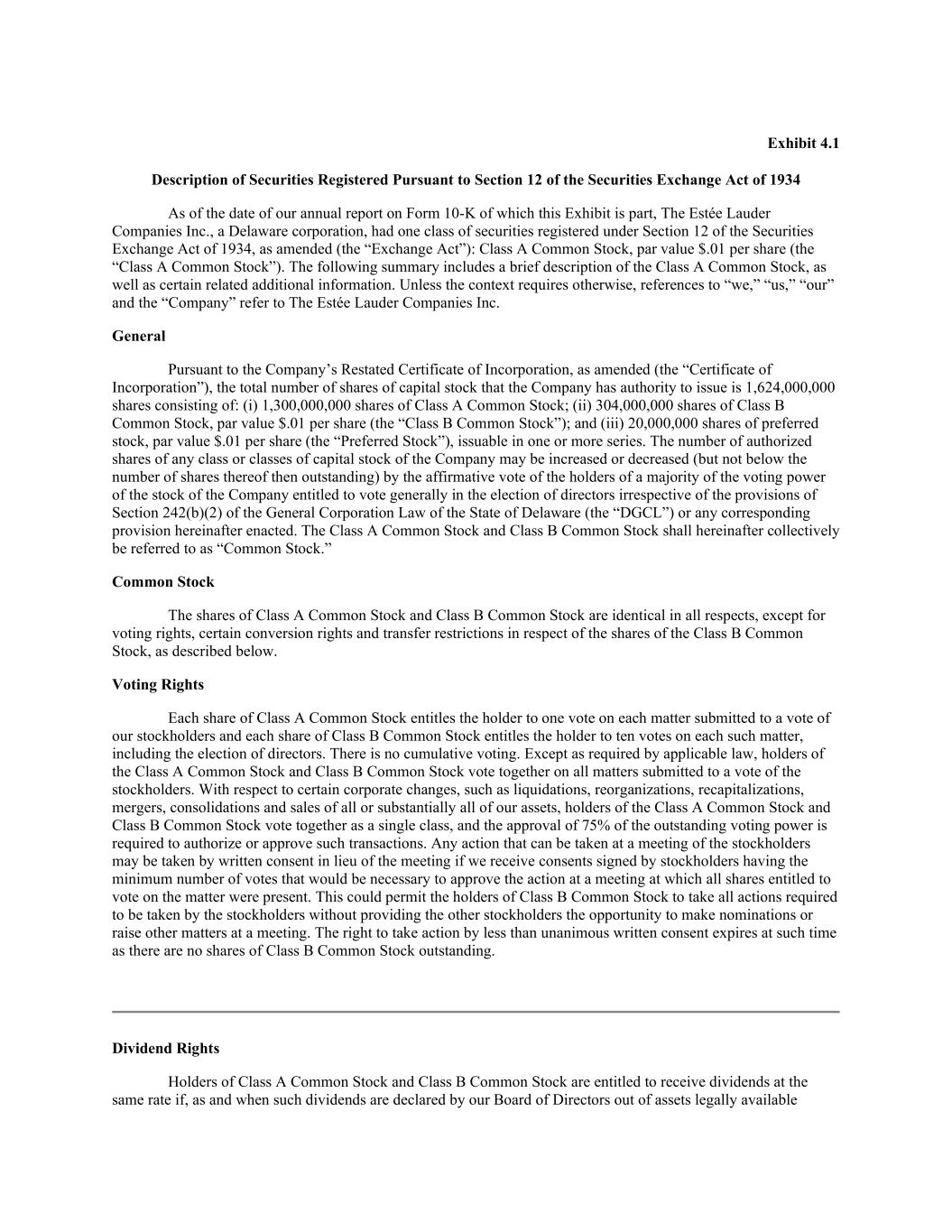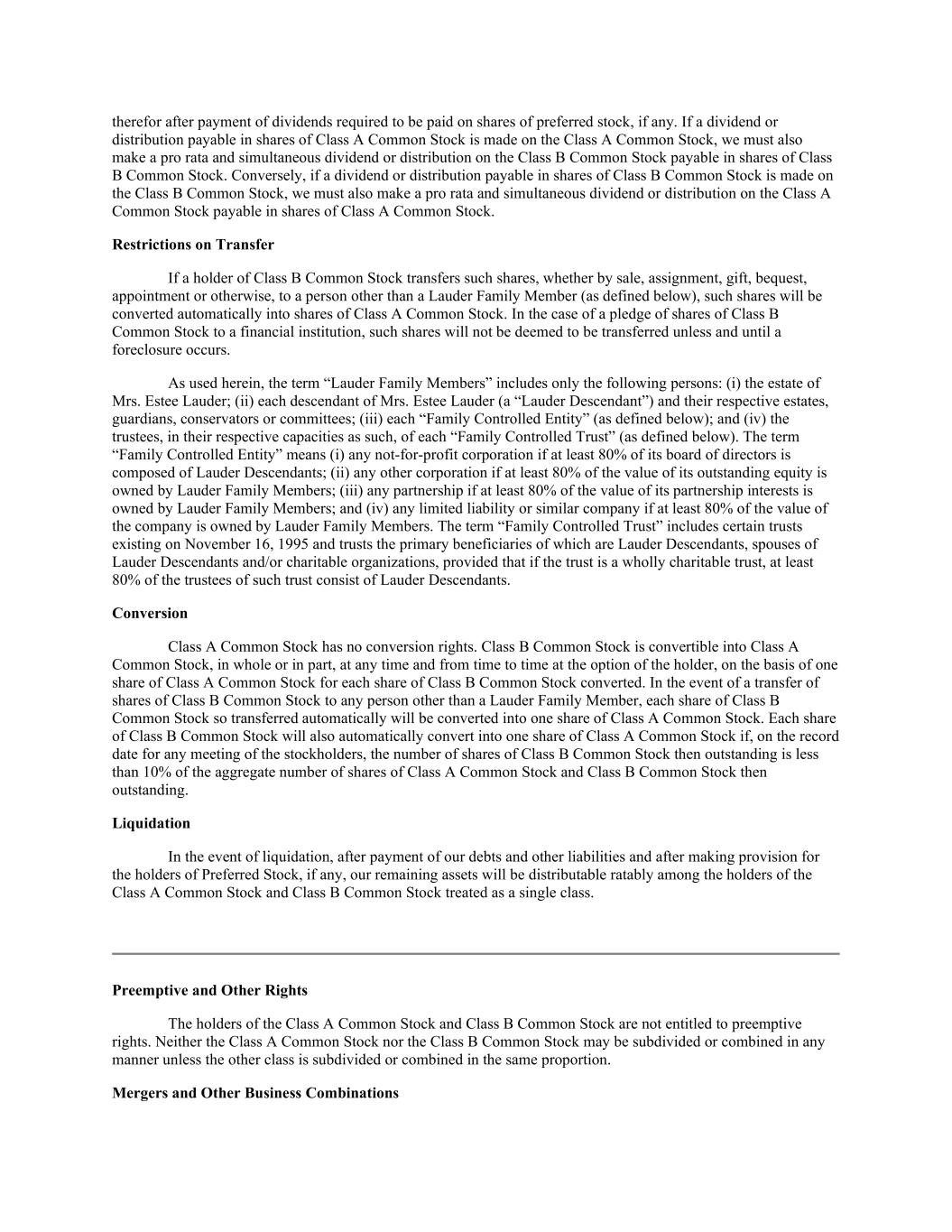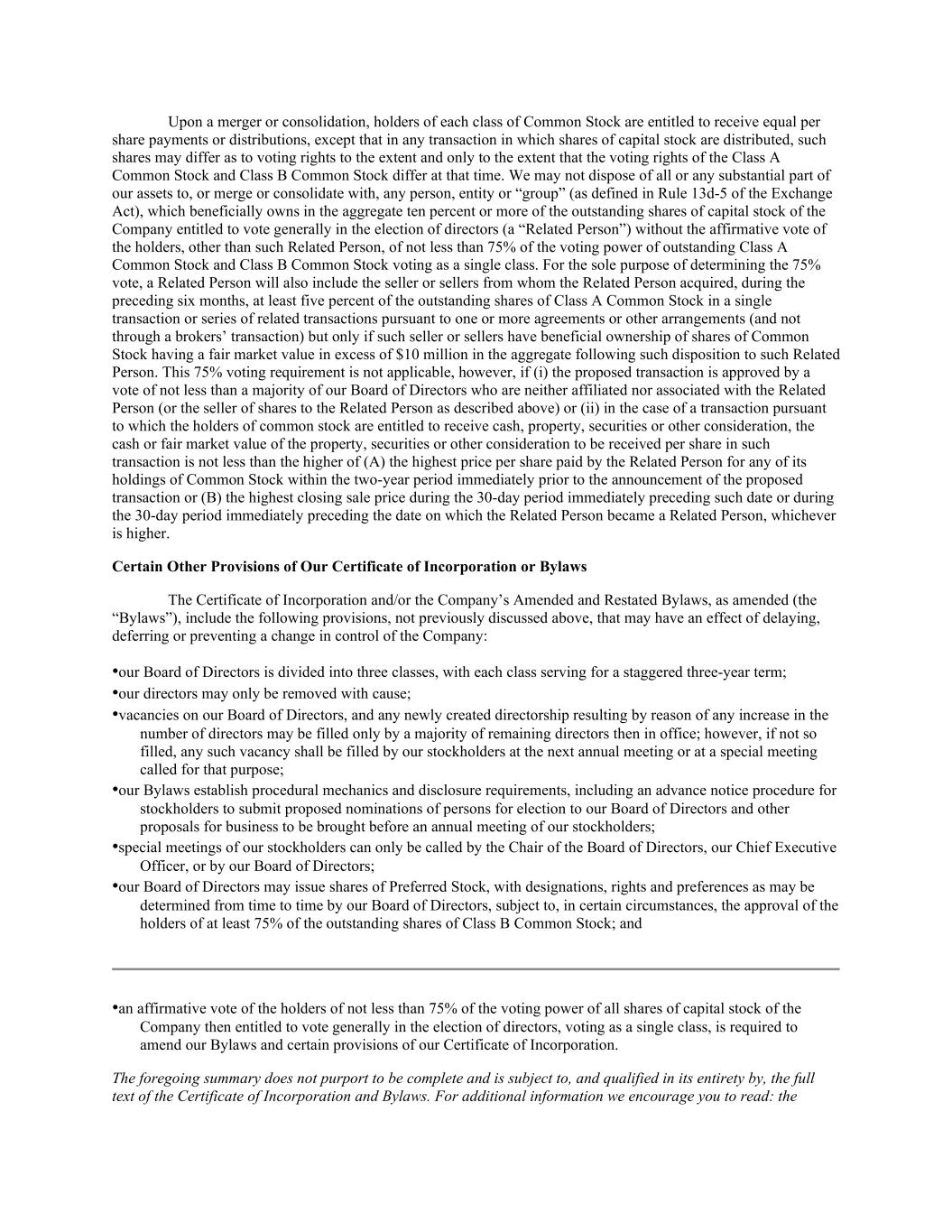
Exhibit 4.1 Description of Securities Registered Pursuant to Section 12 of the Securities Exchange Act of 1934 As of the date of our annual report on Form 10-K of which this Exhibit is part, The Estée Lauder Companies Inc., a Delaware corporation, had one class of securities registered under Section 12 of the Securities Exchange Act of 1934, as amended (the “Exchange Act”): Class A Common Stock, par value $.01 per share (the “Class A Common Stock”). The following summary includes a brief description of the Class A Common Stock, as well as certain related additional information. Unless the context requires otherwise, references to “we,” “us,” “our” and the “Company” refer to The Estée Lauder Companies Inc. General Pursuant to the Company’s Restated Certificate of Incorporation, as amended (the “Certificate of Incorporation”), the total number of shares of capital stock that the Company has authority to issue is 1,624,000,000 shares consisting of: (i) 1,300,000,000 shares of Class A Common Stock; (ii) 304,000,000 shares of Class B Common Stock, par value $.01 per share (the “Class B Common Stock”); and (iii) 20,000,000 shares of preferred stock, par value $.01 per share (the “Preferred Stock”), issuable in one or more series. The number of authorized shares of any class or classes of capital stock of the Company may be increased or decreased (but not below the number of shares thereof then outstanding) by the affirmative vote of the holders of a majority of the voting power of the stock of the Company entitled to vote generally in the election of directors irrespective of the provisions of Section 242(b)(2) of the General Corporation Law of the State of Delaware (the “DGCL”) or any corresponding provision hereinafter enacted. The Class A Common Stock and Class B Common Stock shall hereinafter collectively be referred to as “Common Stock.” Common Stock The shares of Class A Common Stock and Class B Common Stock are identical in all respects, except for voting rights, certain conversion rights and transfer restrictions in respect of the shares of the Class B Common Stock, as described below. Voting Rights Each share of Class A Common Stock entitles the holder to one vote on each matter submitted to a vote of our stockholders and each share of Class B Common Stock entitles the holder to ten votes on each such matter, including the election of directors. There is no cumulative voting. Except as required by applicable law, holders of the Class A Common Stock and Class B Common Stock vote together on all matters submitted to a vote of the stockholders. With respect to certain corporate changes, such as liquidations, reorganizations, recapitalizations, mergers, consolidations and sales of all or substantially all of our assets, holders of the Class A Common Stock and Class B Common Stock vote together as a single class, and the approval of 75% of the outstanding voting power is required to authorize or approve such transactions. Any action that can be taken at a meeting of the stockholders may be taken by written consent in lieu of the meeting if we receive consents signed by stockholders having the minimum number of votes that would be necessary to approve the action at a meeting at which all shares entitled to vote on the matter were present. This could permit the holders of Class B Common Stock to take all actions required to be taken by the stockholders without providing the other stockholders the opportunity to make nominations or raise other matters at a meeting. The right to take action by less than unanimous written consent expires at such time as there are no shares of Class B Common Stock outstanding. Dividend Rights Holders of Class A Common Stock and Class B Common Stock are entitled to receive dividends at the same rate if, as and when such dividends are declared by our Board of Directors out of assets legally available

therefor after payment of dividends required to be paid on shares of preferred stock, if any. If a dividend or distribution payable in shares of Class A Common Stock is made on the Class A Common Stock, we must also make a pro rata and simultaneous dividend or distribution on the Class B Common Stock payable in shares of Class B Common Stock. Conversely, if a dividend or distribution payable in shares of Class B Common Stock is made on the Class B Common Stock, we must also make a pro rata and simultaneous dividend or distribution on the Class A Common Stock payable in shares of Class A Common Stock. Restrictions on Transfer If a holder of Class B Common Stock transfers such shares, whether by sale, assignment, gift, bequest, appointment or otherwise, to a person other than a Lauder Family Member (as defined below), such shares will be converted automatically into shares of Class A Common Stock. In the case of a pledge of shares of Class B Common Stock to a financial institution, such shares will not be deemed to be transferred unless and until a foreclosure occurs. As used herein, the term “Lauder Family Members” includes only the following persons: (i) the estate of Mrs. Estee Lauder; (ii) each descendant of Mrs. Estee Lauder (a “Lauder Descendant”) and their respective estates, guardians, conservators or committees; (iii) each “Family Controlled Entity” (as defined below); and (iv) the trustees, in their respective capacities as such, of each “Family Controlled Trust” (as defined below). The term “Family Controlled Entity” means (i) any not-for-profit corporation if at least 80% of its board of directors is composed of Lauder Descendants; (ii) any other corporation if at least 80% of the value of its outstanding equity is owned by Lauder Family Members; (iii) any partnership if at least 80% of the value of its partnership interests is owned by Lauder Family Members; and (iv) any limited liability or similar company if at least 80% of the value of the company is owned by Lauder Family Members. The term “Family Controlled Trust” includes certain trusts existing on November 16, 1995 and trusts the primary beneficiaries of which are Lauder Descendants, spouses of Lauder Descendants and/or charitable organizations, provided that if the trust is a wholly charitable trust, at least 80% of the trustees of such trust consist of Lauder Descendants. Conversion Class A Common Stock has no conversion rights. Class B Common Stock is convertible into Class A Common Stock, in whole or in part, at any time and from time to time at the option of the holder, on the basis of one share of Class A Common Stock for each share of Class B Common Stock converted. In the event of a transfer of shares of Class B Common Stock to any person other than a Lauder Family Member, each share of Class B Common Stock so transferred automatically will be converted into one share of Class A Common Stock. Each share of Class B Common Stock will also automatically convert into one share of Class A Common Stock if, on the record date for any meeting of the stockholders, the number of shares of Class B Common Stock then outstanding is less than 10% of the aggregate number of shares of Class A Common Stock and Class B Common Stock then outstanding. Liquidation In the event of liquidation, after payment of our debts and other liabilities and after making provision for the holders of Preferred Stock, if any, our remaining assets will be distributable ratably among the holders of the Class A Common Stock and Class B Common Stock treated as a single class. Preemptive and Other Rights The holders of the Class A Common Stock and Class B Common Stock are not entitled to preemptive rights. Neither the Class A Common Stock nor the Class B Common Stock may be subdivided or combined in any manner unless the other class is subdivided or combined in the same proportion. Mergers and Other Business Combinations

Upon a merger or consolidation, holders of each class of Common Stock are entitled to receive equal per share payments or distributions, except that in any transaction in which shares of capital stock are distributed, such shares may differ as to voting rights to the extent and only to the extent that the voting rights of the Class A Common Stock and Class B Common Stock differ at that time. We may not dispose of all or any substantial part of our assets to, or merge or consolidate with, any person, entity or “group” (as defined in Rule 13d-5 of the Exchange Act), which beneficially owns in the aggregate ten percent or more of the outstanding shares of capital stock of the Company entitled to vote generally in the election of directors (a “Related Person”) without the affirmative vote of the holders, other than such Related Person, of not less than 75% of the voting power of outstanding Class A Common Stock and Class B Common Stock voting as a single class. For the sole purpose of determining the 75% vote, a Related Person will also include the seller or sellers from whom the Related Person acquired, during the preceding six months, at least five percent of the outstanding shares of Class A Common Stock in a single transaction or series of related transactions pursuant to one or more agreements or other arrangements (and not through a brokers’ transaction) but only if such seller or sellers have beneficial ownership of shares of Common Stock having a fair market value in excess of $10 million in the aggregate following such disposition to such Related Person. This 75% voting requirement is not applicable, however, if (i) the proposed transaction is approved by a vote of not less than a majority of our Board of Directors who are neither affiliated nor associated with the Related Person (or the seller of shares to the Related Person as described above) or (ii) in the case of a transaction pursuant to which the holders of common stock are entitled to receive cash, property, securities or other consideration, the cash or fair market value of the property, securities or other consideration to be received per share in such transaction is not less than the higher of (A) the highest price per share paid by the Related Person for any of its holdings of Common Stock within the two-year period immediately prior to the announcement of the proposed transaction or (B) the highest closing sale price during the 30-day period immediately preceding such date or during the 30-day period immediately preceding the date on which the Related Person became a Related Person, whichever is higher. Certain Other Provisions of Our Certificate of Incorporation or Bylaws The Certificate of Incorporation and/or the Company’s Amended and Restated Bylaws, as amended (the “Bylaws”), include the following provisions, not previously discussed above, that may have an effect of delaying, deferring or preventing a change in control of the Company: •our Board of Directors is divided into three classes, with each class serving for a staggered three-year term; •our directors may only be removed with cause; •vacancies on our Board of Directors, and any newly created directorship resulting by reason of any increase in the number of directors may be filled only by a majority of remaining directors then in office; however, if not so filled, any such vacancy shall be filled by our stockholders at the next annual meeting or at a special meeting called for that purpose; •our Bylaws establish procedural mechanics and disclosure requirements, including an advance notice procedure for stockholders to submit proposed nominations of persons for election to our Board of Directors and other proposals for business to be brought before an annual meeting of our stockholders; •special meetings of our stockholders can only be called by the Chair of the Board of Directors, our Chief Executive Officer, or by our Board of Directors; •our Board of Directors may issue shares of Preferred Stock, with designations, rights and preferences as may be determined from time to time by our Board of Directors, subject to, in certain circumstances, the approval of the holders of at least 75% of the outstanding shares of Class B Common Stock; and •an affirmative vote of the holders of not less than 75% of the voting power of all shares of capital stock of the Company then entitled to vote generally in the election of directors, voting as a single class, is required to amend our Bylaws and certain provisions of our Certificate of Incorporation. The foregoing summary does not purport to be complete and is subject to, and qualified in its entirety by, the full text of the Certificate of Incorporation and Bylaws. For additional information we encourage you to read: the

Certificate of Incorporation and Bylaws, as well as the Stockholders’ Agreement, dated November 22, 1995, among the Company and certain of the Lauder Family Members (and amendments thereto), and the Registration Rights Agreement, dated November 22, 1995, among the Company, certain Lauder Family Members and Morgan Guaranty Trust Company of New York (and amendments thereto), all of which are exhibits to our Annual Report on Form 10- K; and applicable provisions of the DGCL, including Section 203.